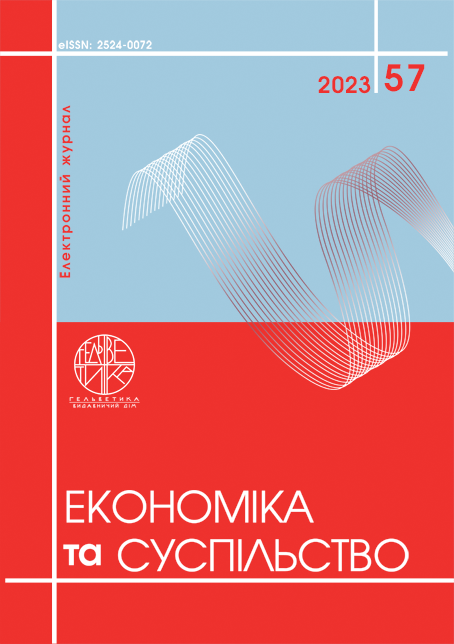THE PLACE OF ORGANIZATIONAL AND ECONOMIC MECHANISMS IN THE IMPLEMENTATION OF AN INNOVATIVE DEVELOPMENT MODEL: BIBLIOMETRIC ANALYSIS
Abstract
The article carries out a bibliometric analysis of publications in the Scopus and WoS scientometric databases regarding social infrastructure in the aspect of innovative development and state support. the development of social infrastructure becomes the main tool for ensuring the quality of life of the population. The duality of the relationship between the level of the quality of life of the population and the innovative and economic development of the state is manifested through synergistic interaction in the aspect of cause and effect results of the formation of the intellectual and innovative potential of the country.
References
Дєгтяр, А., & Серьогіна-Берестовська, О. (2018). Theoretical aspects of management of development of social infrastructure in the region. Public Management, 5 (15), 233-243. DOI: https://doi.org/10.32689/2617-2224-2018-15-5-233-243
Van Eck, N. J., & Waltman, L. (2010). Software survey: VOS-viewer, a computer program for bibliometric mapping. Scientometrics, 84(2), 523-538. DOI: https://doi.org/10.1007/s11192-009-0146-3
Caballero-Morales. (2021). Innovation as recovery strategy for SMEs in emerging economies during the COVID-19 pandemic. Research in International Business and Finance, 57. DOI: https://doi.org/10.1016/j.ribaf.2021.101396
Yang. (2016). Innovative application of the public-private partnership model to the electric vehicle charging infrastructure in China. Sustainability, 8(8). DOI: https://doi.org/10.3390/su8080738
Klievink. (2014). Developing Multi-Layer Information Infrastructures: Advancing Social Innovation through Public-Private Governance. Information Systems Management, 31(3), 240–249. DOI: https://doi.org/10.1080/10580530.2014.923268
Živojinović. (2019). Social innovation to sustain rural communities: Overcoming institutional challenges in Serbia. Sustainability, 11(24). DOI: https://doi.org/10.3390/su11247248
Mont, O. (2014) Sustainable lifestyles 2050: Stakeholder visions, emerging practices and future research. Journal of cleaner production. [Online] 6324–32.
Marti. (2023). Analysis of European competitiveness based on its innovative capacity and digitalization level. Technology in Society, 72. DOI: https://doi.org/10.1016/j.techsoc.2023.102206
McCoyd, J. L., Curran, L., Candelario, E., Findley, P. A., & Hennessey, K. (2023). Social service providers under COVID-19 duress: adaptation, burnout, and resilience. Journal of Social Work, 23(1), 85–102. DOI: https://doi.org/10.1177/14680173221109414
Bricocoli, M., Marani, B., & Sabatinelli, S. (2022). The Spaces of Social Services as Social Infrastructure: Insights From a Policy-Innovation Project in Milan. Urban Planning, 7(4), 381–397. DOI: https://doi.org/10.17645/up.v7i4.5720
Stoustrup, S.W. (2022) A rural laboratory in the Austrian alm—Tracing the contingent processes fostering social innovation at the local level. Sociologia Ruralis, 62, 542–563. DOI: https://doi-org.sire.ub.edu/10.1111/soru.12372
Biggs, R., Westley, F.R. & Carpenter, S.R. (2010) Navigating the back loop: fostering social innovation and transformation in ecosystem management. Ecology and Society, 15(2), 9.
Simone, AbdouMaliq. (2021). Ritornello: “People as infrastructure”. Urban Geography, 1–8. DOI: https://doi-org.sire.ub.edu/10.1080/02723638.2021.1894397
Simone, AbdouMaliq. (2004). People as infrastructure: Intersecting fragments in Johannesburg. Public Culture, 16(3), 407–429. DOI: https://doi-org.sire.ub.edu/10.1215/08992363-16-3-407
McFarlane, Colin, & Silver, Jonathon. (2017). Navigating the city: Dialectics of everyday urbanism. Transactions of the Institute of British Geographers, 42(3), 458–471. DOI: https://doi-org.sire.ub.edu/10.1111/tran.12175
Desai, Renu, McFarlane, Colin, & Graham, Stephen. (2014). The politics of open defecation: Informality, body, and infrastructure in Mumbai. Antipode, 47(1), 98–120. DOI: https://doi-org.sire.ub.edu/10.1111/anti.12117
Truelove, Yaffa. (2011). (Re-)Conceptualizing water inequality in Delhi, India through a feminist political ecology framework. Geoforum, 42(2), 143–152. DOI: https://doi-org.sire.ub.edu/10.1016/j.geoforum.2011.01.00
Lo, Lucia, Preston, Valerie, Anisef, Paul, Basu, Ranu, & Wang, Shuguang. (2015). Social infrastructure and vulnerability in the suburbs. University of Toronto Press.
Klinenberg, Eric. (2018). Palaces for the people: How to build a more equal and united society. Penguin Random House.
Högström, E., Berglund-Snodgrass, L., & Fjellfeldt, M. (2022). The Challenges of Social Infrastructure for Urban Planning. Urban Planning, 7(4), 377–380. DOI: https://doi.org/10.17645/up.v7i4.6526
Ягодка А.Г. Соціальна інфраструктура і політика. URL: http://ubooks.com.ua/books/00093/inx4.php
Gnaneshwari R. Social infrastructure. URL: https://www.slideshare.net/EshwariEshu2/social-infrastructure-59198128
Atkociuniene. (2014). Development of rural social infrastructure based on community needs. Economic Science for Rural Development : Proceedings of the International Scientific Conference, 36, 165–172.
Planning for social infrastructure and community services for urban growth areas. Implementaition guide. URL: http://www.charlessturt.sa.gov.au /contentFile.aspx?filename=Planning%20Social%20Infrastructure%20and%20Co mmunity%20Services%20for%20Urban%20Growth%20Areas%20%20Feburary% 202012.pdf.
Sierra, L.A., Pellicer, E. and Yepes, V. (2017) “Method for estimating the social sustainability of Infrastructure Projects,” Environmental Impact Assessment Review, 65, pp. 41–53. DOI: https://doi.org/10.1016/j.eiar.2017.02.004.
Zeng, S.X. et al. (2015) “Social responsibility of major infrastructure projects in China,” International Journal of Project Management, 33(3), pp. 537–548. DOI: https://doi.org/10.1016/j.ijproman.2014.07.007.
Wang, Z., Dong, Y. and Jin, W. (2021) “Life-cycle cost analysis of deteriorating civil infrastructures incorporating social sustainability,” Journal of Infrastructure Systems, 27(3). DOI: https://doi.org/10.1061/(asce)is.1943-555x.0000607
Danko, Y. I., & Reznik, N. P. (2019). Contemporary challenges for China and Ukraine and perspectives for overcoming these challenges. Global Trade and Customs Journal, 14(6).
Nifatova, O., Ladyka, V., Hryshyna, Y., & Danko, Y. (2023). Agricultural education in times of war: Strategic visions, leadership practices and post-war reconstruction. Problems and Perspectives in Management, 21, 87–97.
Copyright (c) 2023 Сюй Вейдун

This work is licensed under a Creative Commons Attribution 4.0 International License.


